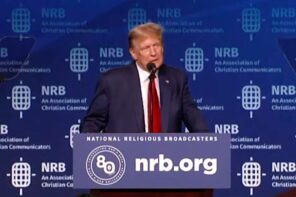In his recent RD piece, law professor Bruce Ledewitz does a good job telling the story of the trend toward diminished protections for the free exercise of religion over the past couple of decades of federal jurisprudence. But it’s not the whole story.
He is correct in asserting that the courts have—due in large part to Justice Antonin Scalia’s opinion for the majority in 1990’s Employment Division v. Smith decision—increasingly come to treat the free exercise of religion as just another right, due no more heightened level of protection from government encroachment than any other civil right.
But there are two clauses that protect religious liberty in the First Amendment: the Free Exercise Clause and the Establishment Clause. During the same period in which the courts have lowered the bar for protecting the free-exercise principle, they’ve also cut back significantly on protections for the flipside of the coin, the anti-establishment principle.
The combined trends, say many advocates, endanger the lofty constitutional pedestal on which religious liberty has rested. And, if they go unchecked, Americans may one day be forced to re-learn the difficult lessons from centuries of European history that inspired the nation’s founders to protect the “First Freedom” (literally, the first 16 words of the First Amendment) by creating a clear—and unique, at that time, in the annals of human history—institutional separation between religion and the state.
“Unfortunately, the clauses have been watered down to suggest religion needs only to be treated the same as other interests,” said Baptist Joint Committee for Religious Liberty Executive Director Brent Walker, in a written statement for my recent Associated Baptist Press story on the topic. “In fact, often religion should be treated differently—to ensure free exercise by lifting governmentally imposed burdens and prevent establishments by prohibiting government sponsorship of religion. Religion is special and is treated specially by the First Amendment. We must recognize its uniqueness if religious liberty in this country is to be vital over the next decade.”
There was broad agreement across the ideological spectrum (from the ACLU to the Southern Baptist Convention) in the religious-liberty community that Smith spelled trouble for the Free Exercise Clause. As a result, coalitions of odd bedfellows have tried, with mixed success, in the years since 1990 to remedy the decision’s most pernicious effects via legislation (such as the Religious Freedom Restoration Act and the Religious Land Use and Institutionalized Persons Act).
But, when it comes to the Establishment Clause side of the trend, consensus breaks down. That’s because the Smith decision is probably the only church-state opinion Scalia ever penned that religious conservatives don’t like. Yet the trend toward a religion-is-just-another-interest view of the law can work in the (short-term) favor of many conservative religious leaders and advocacy groups.
For instance, recall the rhetoric that George W. Bush and his allies continually employed when he attempted, as the centerpiece of his domestic agenda, to expand government’s ability to fund social services through direct grants to churches and other deeply religious groups. He depicted statutory and regulatory barriers that had, in the past, prevented such grants as unfair impediments to churches participating in the nation’s social-service fabric. Bush and his surrogates contended their efforts were attempts simply to “level the playing field”—their favorite catchphrase—for religious groups that just wanted to help their communities like any other service organization that qualified for government funding.
Religious conservatives (along with a handful of moderate and progressive Catholics and evangelicals) have employed similar level-the-playing-field arguments in their attempts to gain government-funded vouchers for use in parochial and other private schools.
But an unlevel playing field for government-religion interactions existed for most of the 20th century due to case law, legislative decisions, and executive-branch regulations that reflected a special view of religion’s place and history in the constitutional order. Supporters of strong readings of both of the First Amendment’s religion clauses believe that the framers set religion apart precisely because they were keenly aware of its unique power to influence society for both great good and great evil. They knew their European history.
The idea had already begun to take root in the courts, and a series of cases regarding government funding for religious entities (most infamously the Court’s 2002 Zelman v. Simmons-Harris decision that gave the thumbs-up to an Ohio voucher program involving religious schools) chipped away at longstanding restrictions on state funding of deeply religious organizations.
Establishing Establishment
Worse than the funding cases, though, were two recent lines of federal jurisprudence that have made it more difficult for plaintiffs to prove violations of the Establishment Clause.
In one, federal judges have gradually backed away from the high level of protection for the Establishment Clause set up by the Supreme Court’s 1971 Lemon v. Kurtzman decision. In that case (involving public funds for parochial schools in Pennsylvania and Rhode Island), the Court’s majority set up a three-pronged test to determine if a government action created an unconstitutional establishment of religion.
First, the Court said, any government action must have a secular legislative purpose. Second, the action must not, in its primary effect, either advance or inhibit religion. And finally the action must not result in an excessive entanglement between government and religion. If the action violated one or more of the three prongs, then it violated the Establishment Clause.
While the federal courts widely applied the Lemon test during the 1970s and early 1980s, it began to lose favor after the religious right’s leading legal strategists decided to make removing the test goal No. 1 of their strategy to chip away at the wall of church-state separation. While some judges and some decisions still use it, many legal scholars have speculated that it is dying a slow death; some conservative justices (most notably Scalia and Clarence Thomas) and federal appeals-court judges have made a habit, in opinions on church-state cases, of taking swipes at Lemon.
Another line of cases has essentially ignored Establishment Clause questions in favor of a scheme that requires only that the government display “viewpoint neutrality” when providing services or forums of which religious groups might avail themselves. In 1995, the high court handed down Rosenberger v. Rectors and Visitors of the University of Virginia, in which a Christian student group at the school successfully sued for the right to use funds from a compulsory student-activity fee to pay for printing an evangelistic magazine.
Charles Haynes, a senior scholar at the Freedom Forum’s First Amendment Center, said the Establishment Clause trend should cause at least as much concern as the Free Exercise one.
“I would also agree that the post-Smith ‘equal treatment’ of religion does, indeed, make the Free Exercise Clause a redundancy—and seriously undermines our nation’s commitment to freedom of conscience,” he said. “But ‘equal treatment’ under the Establishment Clause is an ever-greater threat to religious freedom in the long run because it erodes religious autonomy and authenticity through reliance on state funding. Taken together, both trends are a serious threat to religious freedom in America.”
To be fair, some church-state scholars—as lawyers are wont to do—argue details, cautioning that the sturm und drang among religious-freedom advocates over religion’s imperiled place in the constitutional order may be overblown.
“I think the scope of change can easily be overstated—and often is, by those on both sides of the church-state debates, who have reasons to highlight changes as signs of deeper problem,” said Robert Tuttle, a George Washington University Law School professor who is, along with colleague Ira “Chip” Lupu, a well-regarded expert in religion law. “Religious conservatives argue that the culture is more hostile to religious commitments; [church-state] separationists feel that the state’s latitude to promote religion has expanded and is being used aggressively. Both can point to stories that seem to reflect the concerns.”
Tuttle and Lupu both noted that protections for free exercise, as a practical matter, were not as strong in the pre-Smith era as many religious-liberty activists would like to pretend—and that the legislative attempts to remedy Smith’s damage may actually leave some plaintiffs better able to defend their free-exercise rights than before. And other rulings on both free-exercise and non-establishment cases—such as in employment cases involving churches and cases involving government-sanctioned prayer—have maintained a distinctiveness for religion as a constitutional category.
But other learned First Amendment scholars—such as Marci Hamilton of Yeshiva University’s Cardozo Law School and the University of Virginia’s Douglas Laycock—argue along with religious-liberty activists that the courts have reduced their emphasis on religion’s uniqueness in recent years. This, they say, affects enforcement of the Establishment Clause as much as, if not more than, the Free Exercise Clause.
New generations of judges and attorneys accustomed to a more neutral understanding of religion’s constitutional place could, in the future, move the needle further in the religion-as-just-another-interest direction. And then one day, while emboldened secularists do away with religious tax exemptions, and increasingly government-dependent religious groups compromise their integrity to curry favor with political leaders, Americans might wake up to find that the robust religious freedom they enjoyed back at the beginning of the 21st century had become extinct before anyone even noticed it was endangered.




